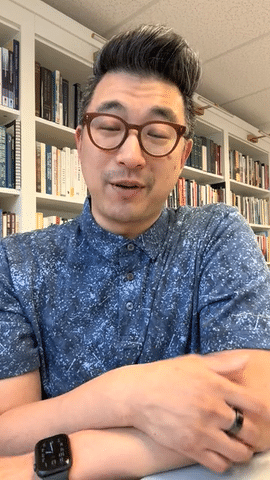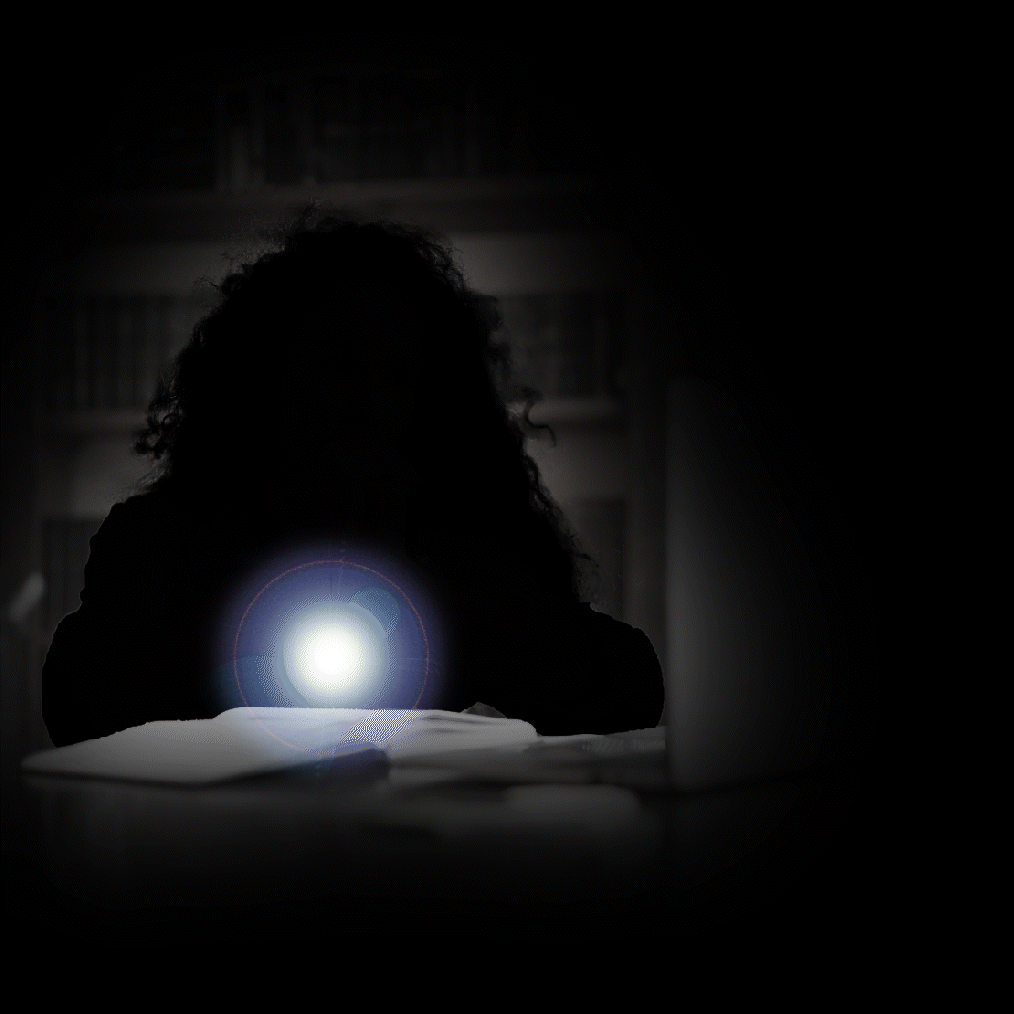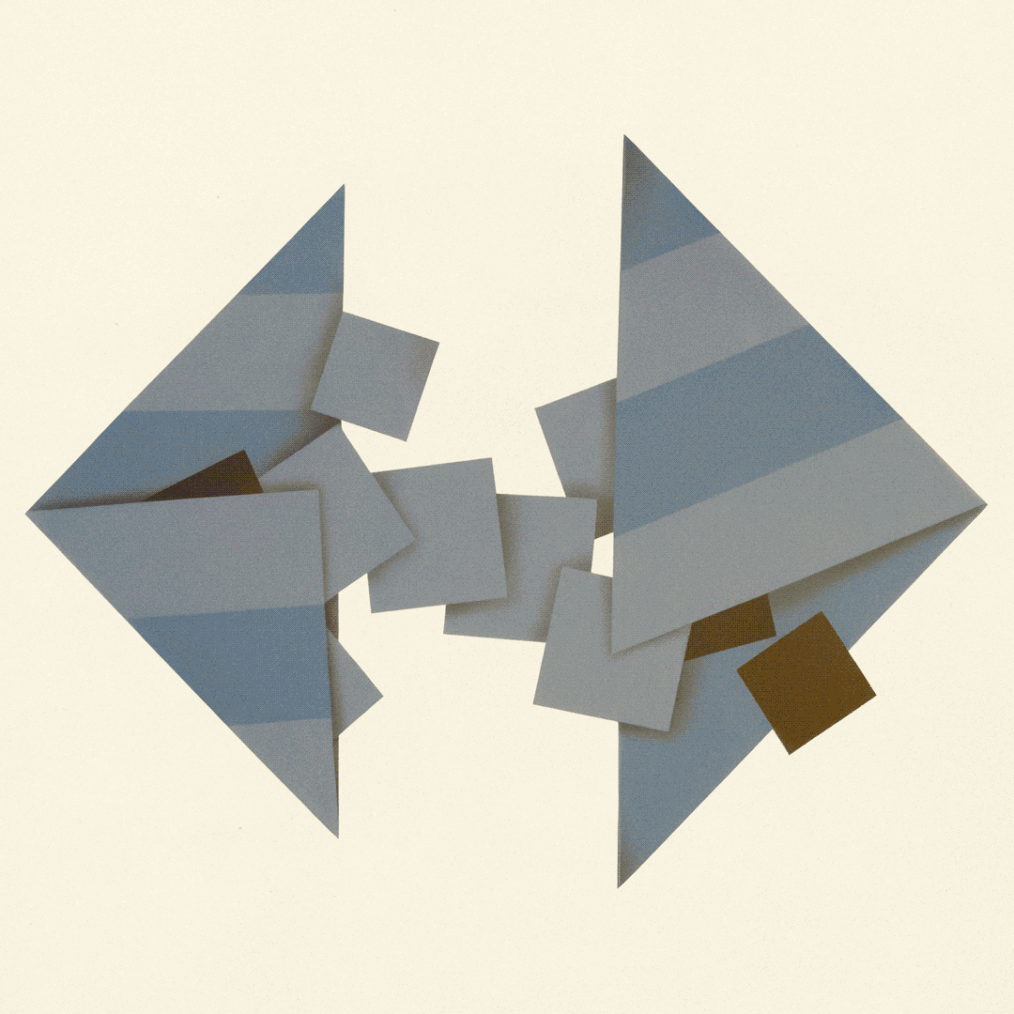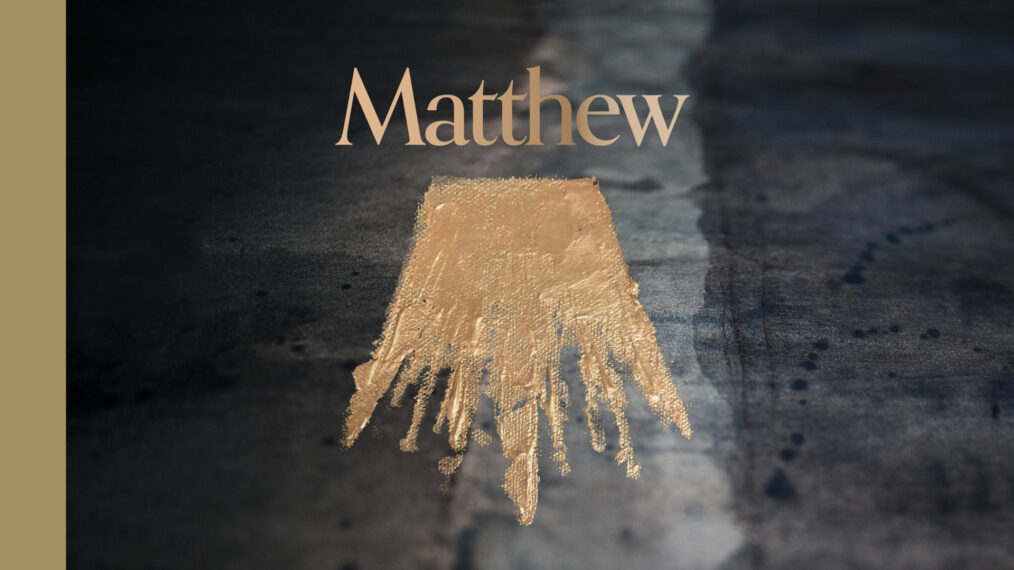Learn more about Christ in the Psalms weekly artwork and see previous pieces here.
Person: Myra Ferguson
As a digital media subject matter expert, I wrote “How to Cheat in Adobe Animate CC: The Art of Design and Animation” and have authored video courses for Photoshop and Illustrator. I also teach part time at the University of Colorado Boulder, provide video tutorials and articles to help InDesign users convert their layouts to interactive HTML5 content, and do projects in conjunction with Adobe and LinkedIn. My portfolio is available at myraferguson.myportfolio.com.
Piece: Photoshop Composition with Animated A.R. Experience
This piece focuses on the first part of Psalm 142:3, “When my spirit grows faint within me.” The darkened silhouette of the woman contrasts with light of the spirit. The image alone didn’t fully capture the sentiment, so I animated it. The animated version shows the light shrinking, fading, and flickering in a continuous loop. In addition to the animation, the augmented reality (AR) aspect includes the animation placed on a cube in order to represent the block of time where that feeling was experienced.
This piece began as an exercise for Project 101010, for which I created an animated GIF. I revised that result to create this version.
For the image, I started with an Adobe Stock image of a woman sitting at a desk with a laptop. In Photoshop, I desaturated the image, selected the subject, added a layer mask, and darkened her to create the silhouette effect. I inverted and modified the selection to darken the rest of the image around her. I added a lens flare that I modified to represent the spirit.
Then I created the animation by taking the layered Photoshop document into After Effects where I added a flicker effect to the modified lens flare and animated the scale and transparency of it. I exported a PNG sequence of the animation to use in the A.R. part.
I imported the PNG sequence in Adobe Aero and added the behavior to make the animation automatically play and loop. In Substance 3D Stager, I made a cube and added a material that I modified to go with the look of animation. I imported the cube into Adobe Aero and published the A.R. experience which generated the QR code.
Then, I added the QR code and instructions for accessing the A.R. experience to the image in Photoshop.
Set apart 10-30 minutes at some point on Saturday to work through this meditation slowly as an individual or household. Have a timer handy for moments of silence.
Read
John 19:38-42
After these things Joseph of Arimathea, who was a disciple of Jesus, but secretly for fear of the Jews, asked Pilate that he might take away the body of Jesus, and Pilate gave him permission. So he came and took away his body. Nicodemus also, who earlier had come to Jesus by night, came bringing a mixture of myrrh and aloes, about seventy-five pounds in weight. So they took the body of Jesus and bound it in linen cloths with the spices, as is the burial custom of the Jews. Now in the place where he was crucified there was a garden, and in the garden a new tomb in which no one had yet been laid. So because of the Jewish day of Preparation, since the tomb was close at hand, they laid Jesus there.
Reflect
Holy Saturday. A day we often miss entirely. In our flurry and hurry of preparation to ready ourselves for the celebration of Easter morning, we forget that there was an entire 24-hour day in between the horrors of Good Friday and the joys of Easter. More than a full day between death and life. Between the last exhale and the next inhale. A full day between the darkness of despair and the dawn of new hope.
We already know the full story, so it’s easy enough for us to skip straight to the “happy ending.” That feels more comfortable and much less awkward to us, especially in this day and age. And, if we’re honest, this is what we’re tempted to do with all of our problems, griefs and “little deaths” we experience during our time on earth. We tell ourselves, “everything will be fine in the end!” We push down our discomfort and sadness, jumping straight to an optimistic perspective. We find silver linings. We sugar-coat. We strive to turn our situation around as quickly as possible, and if that doesn’t succeed, we often try to escape, or medicate, or numb ourselves from feeling the pain. These are considered normal reactions in our broken world.
But is it how God intended us to live?
Why would God allow for an entire day between Good Friday and Easter? Is it “productive?” What good does it do us? What good did it do the disciples? Couldn’t Jesus have risen on Holy Saturday? Or, for that matter, immediately after being crucified? Why did He make the disciples wait till the third day?
It seems that, through some great mystery, God chose to use the waiting and silence of Holy Saturday for some deeper meaning and purpose. God’s thoughts are not our thoughts, His ways are not our ways, and His timing is not our timing. It wasn’t Abraham’s timing, waiting for a promised child. It wasn’t Job’s timing, waiting for his family to be restored. And it wasn’t the disciples’ timing, waiting for the coming Kingdom and the resurrection.
So how do we approach these “confusing in-betweens” with appropriate health and faith? Have you ever considered how Jesus, the only perfect human to ever live, wept over the death of His friend Lazarus? He took real time to feel sadness and grief even though He knew He would resurrect Lazarus from the dead within a few hours! Jesus models time and time again that we are made as humans to slow down, to allow ourselves to feel emotions before God, and to wait for God to move in His timing.
On Holy Saturday we remember this most painfully confusing “in-between” that the disciples faced millenia ago. But we also recognize that each of us are facing our own “in-betweens” right now, as we wait for God to answer our prayers and ultimately redeem all things. We might be waiting for God to heal a disease or an emotional grief. We might be waiting for reconciliation with a friend or family member. We might be struggling with the recent loss of a life, a home, or a career. We may deeply desire a new relationship or a new chapter in life. We may be waiting for God to pull us out of a “dark night of the soul.” When we slow down, we may even simply feel the weight of the world’s brokenness and our longing for Christ to make all things new.
Yet, through each of these Holy Saturdays we live through, we are not alone. We find ourselves in the company of all who walked with Jesus before us, and even more preciously, we find ourselves in the very presence of our kind Savior who gave up His life for you and me. He who once lay still and breathless in the belly of a cold tomb now sits with us here in this moment.
SILENCE & STILLNESS
Right now, take a few moments to think about one or two “in-betweens” you’re experiencing, whether great or small. As they come to mind, allow yourself to feel sadness over your unmet longings. Silently ask God to fulfill these longings, even if you’ve asked countless times before.
Then, if possible, set a timer for 2-5 minutes to sit in silence and stillness before God. Remember that He is with you. Recognize that He also weeps with you over the “in-betweens.” Allow His presence with you now to bring comfort.
READ
“Holy Saturday” Written by Brent Summers, 2021
A threshold, and an open door,
A pause in sacred time,
Remembering what came before,
To know a plan sublime;
Suspended now ‘tween darkest day
And brightest dawn e’er known,
Our thoughts, unsettled as we pray,
Come to the heav’nly throne.
Today we wait expectantly,
In stillness look again
For patience and humility
As we trust alone in Him.
And in reflections through the day
Our hearts remain steadfast,
For Jesus is our hope and stay,
His love is unsurpassed.
So now we rest and contemplate
The fearful price He paid,
Too soon to join and celebrate;
A tension must be weighed;
To feel the somber gravity,
The solemn call is heard,
With rumors rustling in the breeze,
Profound in ev’ry word.
These liminal reflections bring
A wisdom as we pray,
Will deepen life in everything,
Give meaning to the day.
Oh God, give us the wherewithal
To wait and trust and cope
With passing time that sometimes crawls
Please fill our hearts with hope.
DISCUSS & REFLECT
- What stood out to you from these readings?
- What is God stirring in your heart today?
PRAY
O God, Creator of heaven and earth: Grant that, as the crucified body of your dear Son was laid in the tomb and rested on this holy Sabbath, so we may await with him the coming of the third day, and rise with him to newness of life; who now lives and reigns with you and the Holy Spirit, one God, for ever and ever. Amen. -Book of Common Prayer
END IN SILENCE
Again, set a timer for 2-5 minutes, then sit in silence and stillness before God.
WHAT IS MAUNDY THURSDAY?
Maundy Thursday is the Thursday before Good Friday. It marks the final night that Jesus gathered with His disciples before His crucifixion. On that night He explained the meaning of His death through a modified passover feast, He gave some of his final teachings, and He washed the feet of His disciples teaching them a “new commandment”—to love one another just as He has loved us.
Traditionally, the church has gathered on this night to remember the Lord’s Last Supper and His commandment (latin: mandatum) to “love one another.” We do this by reading Scripture, praying, sharing a meal, and celebrating communion. This is a night of both remembrance and preparation. We slow down on Thursday night to remember the love of Jesus our Suffering Servant, and we prepare our hearts to feel both the sorrow and the gratitude that should particularly mark Good Friday.
WHAT SHOULD WE DO?
READ & PRAY
Prior to the meal, read aloud John 13:1-20 and 33-35. Then take a few minutes to pray around these themes:
- Give thanks for the death and resurrection of Jesus, and the real life community borne in this death and resurrection and seen gathered.
- Ask for help to remember and give weight to the events that this weekend memorializes.
- Ask for help to believe that the death and resurrection of Jesus really grants all that the New Testament claims (forgiveness, adoption, union with Jesus, and new life).
- Pray that God would move through our time together on Friday night and Sunday to help us believe and celebrate all that God has given us in the death and resurrection of Jesus.
EAT & DISCUSS
Share a meal together, discussing the importance of Holy Week. Here are some questions that may help spur on conversation:
- What is the significance of Jesus’ triumphal entry (Palm Sunday)? How was the way in which Jesus the king presented himself surprising to people? How is it surprising and/or difficult to accept for you?
- What took place during the Last Supper? What do we learn about the character of Jesus from that evening? How does this bring joy to you? How is it challenging?
- Why were the events of Good Friday necessary? For what reasons do you think it is hard for us to consider sin and its consequences? How do we see the glory of God in the crucifixion?
- What might prevent us from deep and full celebration on Easter Sunday? In what ways does Easter inspire joy, comfort, and hope? What are ways you can prepare your heart for Good Friday and Easter Sunday?
CELEBRATE THE LORD’S SUPPER
On the night before His death, Jesus taught His disciples the meaning of His death through a modified passover meal that He instituted as a perpetual reminder for all who would follow Him. While celebrating Communion weekly in our gathered worship is a vital practice for our church, celebrating in homes with smaller communities can also be a powerful practice that can help us remember and celebrate what Jesus did for us on the cross. Here are the basic elements involved in celebrating Communion with your community:
- Prepare: To celebrate Communion, you will need wine, grape juice, and bread.
- Remind: Remind your community that we are truly grateful for everyone who is present, but that Communion is a covenant meal that is intended for followers of Jesus.
- Read: Ask someone read 1 Corinthians 11:23-26.
- Serve: Ask two people to serve Communion by offering the bread and the cup, saying:
- “The Body of Christ, broken for you.”
- “The Blood of Christ, shed for you.”
- Sing (Optional): You can sing a simple and well-known hymn like The Doxology.
- Pray: Ask someone close in prayer, thanking Jesus for the love that He has shown us through His sacrificial death on the cross.
PREPARE FOR GOOD FRIDAY
Give some instructions in preparation for Good Friday. Our Good Friday service is very different from what many people have experienced. Encourage your community to arrive early. The service is very dark and is a service of remembrance and mourning. We will read together through the last hours of Jesus’ arrest, trial, and crucifixion. We will sing about the cross. At the end, we will – in silence and darkness – receive the Lord’s Supper and leave.
For many the service is a disorienting one. It is designed to break us from the banality of much of our lives, immerse us in the gravity and sadness that marks Good Friday, and stir in us a longing to see the fruit of this night on Easter. The closing silence is particularly poignant for people as we ask that the whole congregation leave the building and parking lot in silence. Pray for this night. Pray that the Gospel would be clear. Pray that non-Christians, on Good Friday and Easter, would be given faith to believe.
The 40-day season of Lent culminates in Good Friday and Easter, but before there is Good Friday, there is Palm Sunday, Holy Monday, Holy Tuesday, Spy Wednesday, and Maundy Thursday; before Easter Sunday there is Holy Saturday. Just as we can’t leapfrog Good Friday to get to Easter Sunday, we can’t leapfrog these other days either. Each tells an important part of the story of Jesus’ journey toward the cross and eventual resurrection that we so need, and as Robert Webber said, “the Christian year is a gospel superstructure.” These 8 days that precede and include Easter are known as “Holy Week.” While we are “informed not ruled by tradition,” Holy Week can serve as a helpful discipleship tool as it asks us to slow down and immerse us in the days of Jesus just before His death and resurrection.
Looking at individual days, we will ask the same question: if this particular day of Holy Week’s seed were to be planted in our hearts, what might spring up from this day’s ground? How is this day a lens into Jesus’ life and how is this day a mirror to your own life? While we can’t full take in every day, remember that we return year after year. Over time, each day’s meaning and depth will increase!
Day 1: Palm Sunday
While Jesus picked a donkey to ride into Jerusalem (representing humility and peace, thus fulfilling Zechariah 9:9), the people interestingly picked palm branches (representing victory) to welcome Jesus. They assumed that Jesus was coming in as the new king/sheriff who would kick out the evil Roman oppressors similar to Simon Maccabee a generation prior. This reveals that people were still interpreting Jesus through their lens of expectations at this moment: the Messiah vanquishing their enemies. Ironically many of the same people shouting “Hosanna” will be shouting “Crucify him” a few days later, revealing themselves to be Jesus’ enemies… The same crowds who took over their cloaks to make way for Jesus’ entrance into Jerusalem would have Jesus stripped of His clothes to be crucified days later outside of the city.
In Luke’s account, we’re told that Jesus weeps over Jerusalem. What a powerful image, not of a distant ruler but one who’s near enough to feel pain, grief, and anger over sin, death, and its effects on our lives. He’s the humble, weeping King who refuses to conform to our expectations. At the end of this day, He briefly stops by the Temple.
Reflect:
Comparing your heart to Jerusalem, what is your “city” like if Jesus were to come and enter it? Are there gates? What is the response to Him?
Day 2: Holy Monday
On Jesus’ first day on the job as king, He heads back to the temple but this time with a whip and some words. Jesus knew His kingship was directly tied to worship, the Temple, and prayer. God’s heart was for the Temple to be a house of prayer for all nations. As king, He would tear down any barriers keeping people from coming to God! While Jesus is gentle and lowly, He is also appropriately and measuredly angry and confrontational. He’s not emotionally flat or one-dimensional but robustly complex: the humility and weeping of Palm Sunday are held side by side with Holy Monday’s righteous anger. Both are expressions oi the Father’s heart! In Jesus, we see the Father in real time. Jesus’ brief interruption of the buying and selling of sacrifices pointed to His impending death and sacrifice a few days later as the perfect Lamb of God forever doing away with the sacrificial system. On the way to cleanse the temple, Jesus also curses a fig tree because of its fruitless state. This might seem like a random story, but fig trees often represented the nation of Israel in the Old Testament (see Jeremiah 8:13 and Hosea 9:10). In doing this, Jesus was pronouncing judgment on Israel who was out of step with God’s original purposes for her as His people.
Reflect:
Now imagine Jesus came to the “temple” of your heart. What worship might He find? Are there any tables He would flip over in His love and passion? Have any “vendors” set up shop?
Day 3: Holy Tuesday or Fig Tuesday
As Jesus and the disciples return to the temple the next day, they walk by the fig tree cursed by Jesus and find it “withered away to its roots (Mark 11:20-26). This interaction has led some traditions to call this day Fig Tuesday. Just as the fig tree was destroyed, so too would Israel and the temple be facing impending destruction in 70 AD. Though the fig tree symbolically withered, and soon the Temple would be destroyed, Jesus was coming to us as the new Temple where we could meet with God. Through the work eventually accomplished on Good Friday and Easter, we too would be filled by His Spirit that we might bear the fruit that God originally intended for His people, becoming temples of the Living God ourselves!
Reflect:
If your life was a fig tree, what kind of “season” would it be in? Where do the roots run into? By what power will it bear fruit?
Day 4: Spy Wednesday
This day has been dubbed by some as “Spy Wednesday” which reminds us of the evil scheming behind the scenes by Judas agreeing to work with the chief priests to trap and kill Jesus at the right moment. It’s also on this day that we remember Jesus’ anointing in Bethany at dinner by Mary. It’s a picture of extravagant, almost “wasteful” worship of Jesus (“Could this perfume have not been sold to give to the poor?!”) and yet Jesus commends the act… As we begin to see Jesus for who He truly is, we become less like Judas and more like Mary! We realize He’s the greatest treasure and worth laying down anything for… Instead of taking money from the chief priests like Judas, we pour out our most valuable possessions on Jesus. He saw this as a preparation for His burial and this anointing was an additional sign pointing to Jesus as our Messiah, our “Anointed One” (Isaiah 63:1-3). Many think this fragrance lingered with and on Him throughout the next couple of days! Jesus’ life being poured out as a fragrant offering would have been witnessed by Judas, Pilate, the soldiers, and even the thieves crucified at his side… Mary’s worship would have been the last thing Jesus smelled before He took His last breath.
Reflect:
Where in your life have you been most like Mary?
Day 5: Maundy Thursday
On this day begins what’s known as the final three days before Easter known as the Easter Triduum or the Paschal Triduum. These are called Maundy Thursday, Good Friday, and Holy Saturday. Maundy Thursday gets its name “Maundy” from the Latin word for “mandate.” Jesus gave His disciples a new commandment or “mandate” on this evening: to love one another. This last day that Jesus spent with His disciples is understandably chock-full of powerful interactions and conversations: they include Jesus washing His disciples’ feet, establishing the Lord’s Supper, the Upper Room Discourse, the High Priestly prayer, singing with the disciples, and then heading to the Garden of Gethsemane to pray.
Reflect:
The washing of feet can be hard to picture in our current context. Imagine that Jesus wanted to serve you by helping with something unpleasant but necessary. Maybe it’s cleaning out your car or scrubbing a bathroom floor. How does your heart respond? Will you let Him?
Observe:
For an extended guide on observing Maundy Thursday with others, please click here.
Day 6: Good Friday
It’s on this day that the Son of God was crucified. How is this day “good”? Shouldn’t it be “Bad Friday” or “Worst Friday?” Some traditions call it “Sorrowful Friday.” Others think Good Friday stems from the name “God’s Friday.” We’re not sure, but we know that in order for the goodness of Easter to be accomplished, all the events of Friday had to take place as well. Resurrection doesn’t come apart from death. Just as things accelerated on Maundy Thursday so we’re overwhelmed by the cascading events that lead us to Jesus’ death: The betrayal by Judas, abandonment by His disciples, denial by Peter, Jesus’ appearance before the Sanhedrin as well as Pontius Pilate and Herod, the release of Barabbas, the mocking and beating and torture of Jesus before Him marching to Golgotha and being nailed to a tree. A few hours later (and many details and interactions excluded here), Jesus declares “it is finished” and breathes His last and the Temple curtain tears from top to bottom. Good Friday ends with Jesus’ burial in Joseph of Arimathea’s tomb.
Reflect:
Imagine walking away after seeing the tomb closed. What are you thinking?
Day 7: Holy Saturday
Between the cries of agony of Good Friday and festive shouts of Easter Sunday is Holy Saturday. Apart from soldiers being issued to guard Jesus’ tomb on this day, the only other thing we’re met with on this day is silence. Deathly uncomfortable silence. Jesus laid to rest, along with all the hopes and dreams that dwelled in Him. There’s no easy fix, no band-aid, no immediate eject button to get us out of this hell. Just sitting in our grief and confusion. Holy Saturday invites us to both grieve the realities we’re confronted with but also turn to God as we wait. In his book “Lent,” Esau McCaulley comments about this day, “This is how the season of Lent concludes. Things are quiet. We are quiet. We stand at the tomb wondering what God will do next. Whether we have kept our fasts or failed has no bearing on the final outcome. God either has the power to raise Christ from the dead, or he does not. We are Christians because we have concluded that he does. That means we can rest.”
Observe
For an extended guide on observing Holy Saturday with reading and reflection, please click here.
At Park Church, we use visual artwork as an accompaniment to sermon series, church calendar seasons, church holidays, and some events. Besides the simple reality that good art is nice to look at, we also believe that—by engaging a different part of us than words do—artwork helps us learn.
Who is Avo Keerend?
Over the years, we’ve looked to different visual artists inside and outside of our church family to create our artwork. However, this year for Lent and Holy week, we’re looking several decades back in time to the work of an Estonian graphic artist named Avo Keerend. Keerend (1920–2012) was a trained painter and a prolific linoleum-cut artist, but turned towards making geometric-abstract pieces with letterpress and plastic printing (that is, by hand without a computer) near the end of his career in the 1980s. We’ve used five of these later, geometric-abstract pieces for this Lent and Holy Week collection. Learn more about Avo Keerend’s life here (your web browser will have to translate from Estonian!).
okay—Why does this matter?
We sing songs written before our time, enjoy a church building built before our time, and often reference authors who wrote before our time. Things like this remind us that we’re not the first or the last to live. Granted, for many in our community, these art pieces from the 1980s may not be “before your time!” Even still, to look back 40 years and be moved or challenged by an artistic work can teach us something.
Why these particular images?
In general, abstract geometry has always defied the world of art. Why should painting a circle be so hard? How can a mess of lines stir up so much emotion? How can complex narratives come to mind at the sight of simple shapes?
For a brief answer to these questions, let’s look to a few more-complex art forms. An elaborate oil painting, a hand-woven tapestry, or the sound of a full orchestra are each the work of a thousand soft touches. These types of art can wow us with their wonderful abundance of detail and nuance by giving our senses a lot of “information.” One might say this information comes with a decision to either sort it all out (“What am I seeing? What am I hearing? How is this possible?”), or to simply let it “wash over you” (“What am I feeling?”). How wonderful to choose either!
On the other hand, abstract geometry is wildly different. Compared to an oil painting, a handful of squares or lines pressed onto a canvas (with a just little shading) might take 100,000 less touches. The finished piece gives our senses so much less “information.” To some, this may lead to questions that sounds less like “What am I seeing? What am I feeling?”, and more like “Is this even art?” This is a common and valid opinion! Other viewers may feel significantly moved, even challenged to interpret what they’re seeing.
One Interpretation
As a fan of this artist and this style of artwork, I (JD Raab) wanted to provide one possible “reading” of each panel in this series. But before I begin, it’s important to note that these art pieces from Avo Keerend were not made for the application to which I’ve set them—I have enjoyed interpreting them and applying them as such. This is one of the beautiful strengths of this sort of artwork—it can mean many different things. Let me tell you what I see…
Ash Wednesday
 The squares feel as if they move from left to right and create a narrative. Perhaps only one square moves, but we see it pictured in a few “stages” of its journey? The dark square at the beginning (hidden in the fold of the large left triangle) and the dark square at the end (falling out of the larger right triangle) work as bookmarks in a journey: a start and an end. In particular, we may see a movement reminiscent of Genesis 3:19—from dust to dust; a falling like gravity.
The squares feel as if they move from left to right and create a narrative. Perhaps only one square moves, but we see it pictured in a few “stages” of its journey? The dark square at the beginning (hidden in the fold of the large left triangle) and the dark square at the end (falling out of the larger right triangle) work as bookmarks in a journey: a start and an end. In particular, we may see a movement reminiscent of Genesis 3:19—from dust to dust; a falling like gravity.
Lent
 Though the shapes furthest back in this composition are dark (perhaps representing original “dust,” as referenced in the Ash Wednesday piece), there is a lighter foreground, appearing as a sort of sash over the purple rectangle (Lent is traditionally represented with the color purple). Taken altogether, this purple rectangle can illustrate the tension we feel in this season: mortality and sin is right behind us, but in Christ we are truly wrapped in His righteousness and life. Furthermore, in the image, the black shape is separated from the purple rectangle by this white sash—just as we are ultimately separated from our sin and death. The question of “how is any of that possible?” is appropriately felt!
Though the shapes furthest back in this composition are dark (perhaps representing original “dust,” as referenced in the Ash Wednesday piece), there is a lighter foreground, appearing as a sort of sash over the purple rectangle (Lent is traditionally represented with the color purple). Taken altogether, this purple rectangle can illustrate the tension we feel in this season: mortality and sin is right behind us, but in Christ we are truly wrapped in His righteousness and life. Furthermore, in the image, the black shape is separated from the purple rectangle by this white sash—just as we are ultimately separated from our sin and death. The question of “how is any of that possible?” is appropriately felt!
Palm Sunday
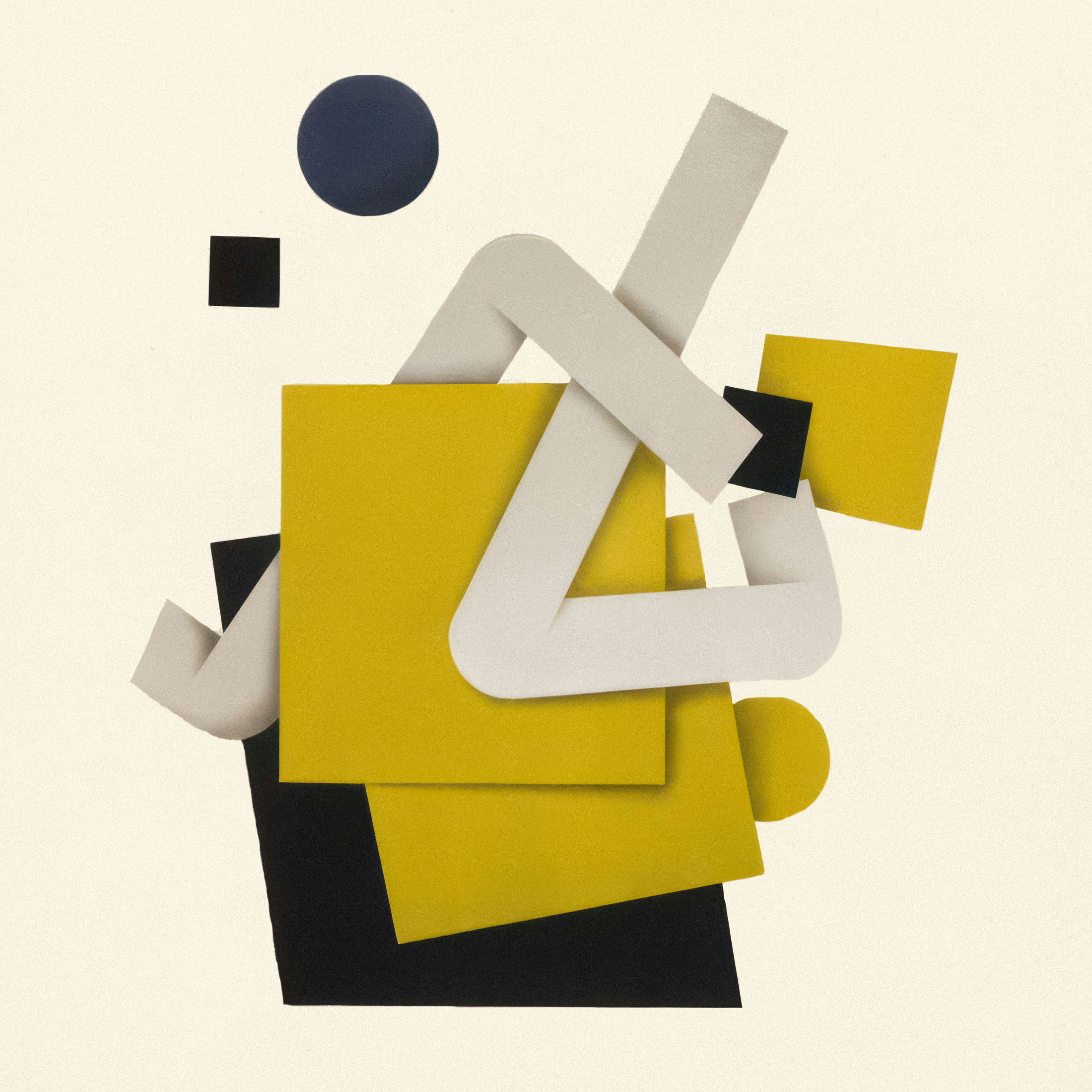 Bright yellow shouts of happiness are present, but as in the previous piece for Lent, dark shapes are furthest back in our image. The irony of Palm Sunday is clear—those who know the whole story can rejoice with a “Hosanna!” while knowing that “Crucify Him!” can come from the same place. We say with David “Unite my heart to fear Your name!” (Psalm 86:11). This art piece also shows a white shape entwined above, between, and below the other shapes. As in our piece for Lent, I see this white “path” representing the presence and foreknowledge of Christ in all of the happenings of Holy Week (and how it plays out in our hearts today).
Bright yellow shouts of happiness are present, but as in the previous piece for Lent, dark shapes are furthest back in our image. The irony of Palm Sunday is clear—those who know the whole story can rejoice with a “Hosanna!” while knowing that “Crucify Him!” can come from the same place. We say with David “Unite my heart to fear Your name!” (Psalm 86:11). This art piece also shows a white shape entwined above, between, and below the other shapes. As in our piece for Lent, I see this white “path” representing the presence and foreknowledge of Christ in all of the happenings of Holy Week (and how it plays out in our hearts today).
GOOD FRIDAY
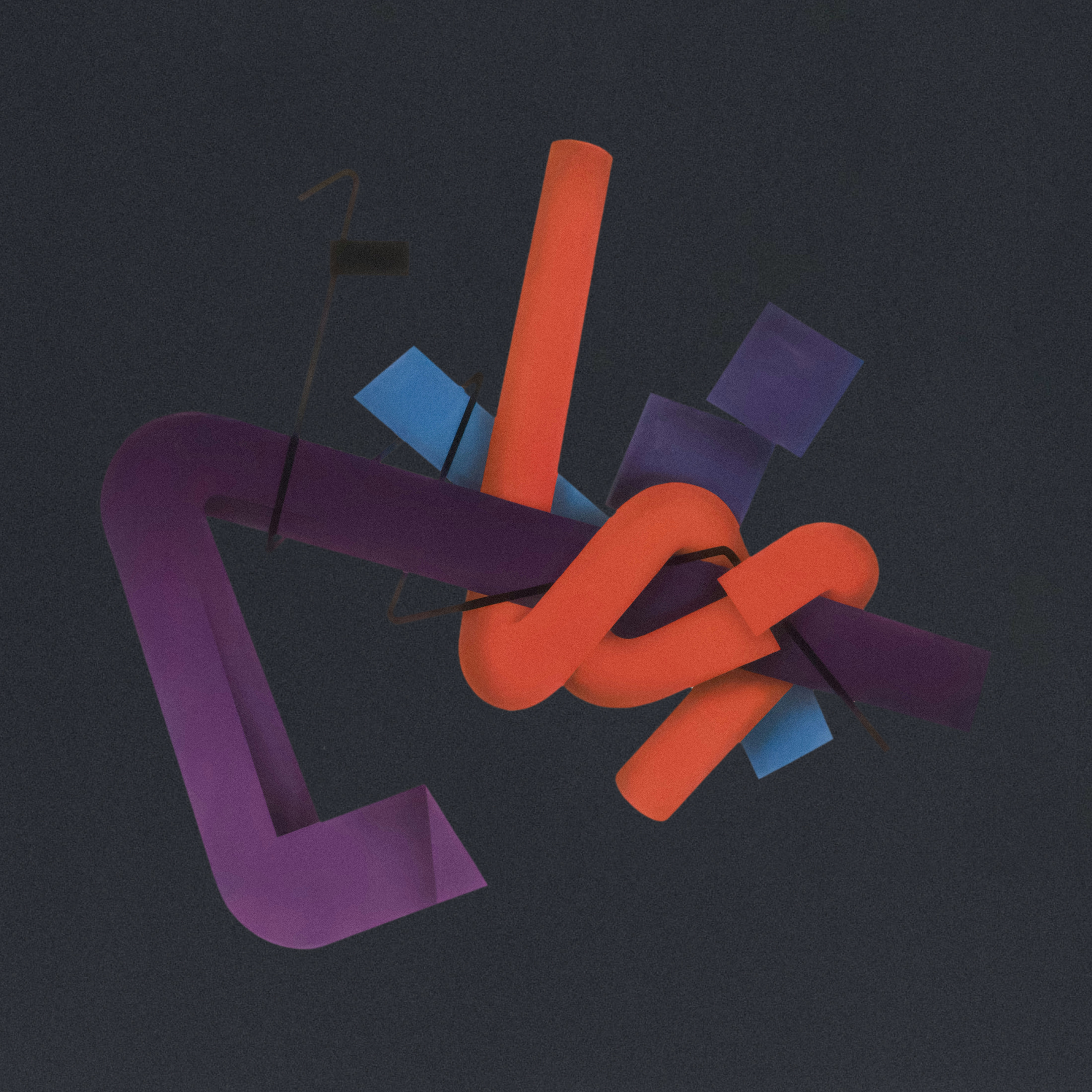 As we get to this piece, all instances of light and warmth are gone. The black present in the other pieces is now the entire background. The white shape and/or path from the previous pieces has turned purple, and is wrapped in red and black serpentine forms. The white turned purple illustrates the royalty of Christ in His death (his upside-down throne). The red and back illustrate the hatred, the sin, and curses that fell on Him in this moment. It’s an entangling, suffocating mess, but the shape representing Jesus is shown as larger as the other shapes, extending well past them and even turning to “see” them. His sovereignty is unaffected.
As we get to this piece, all instances of light and warmth are gone. The black present in the other pieces is now the entire background. The white shape and/or path from the previous pieces has turned purple, and is wrapped in red and black serpentine forms. The white turned purple illustrates the royalty of Christ in His death (his upside-down throne). The red and back illustrate the hatred, the sin, and curses that fell on Him in this moment. It’s an entangling, suffocating mess, but the shape representing Jesus is shown as larger as the other shapes, extending well past them and even turning to “see” them. His sovereignty is unaffected.
EASTER
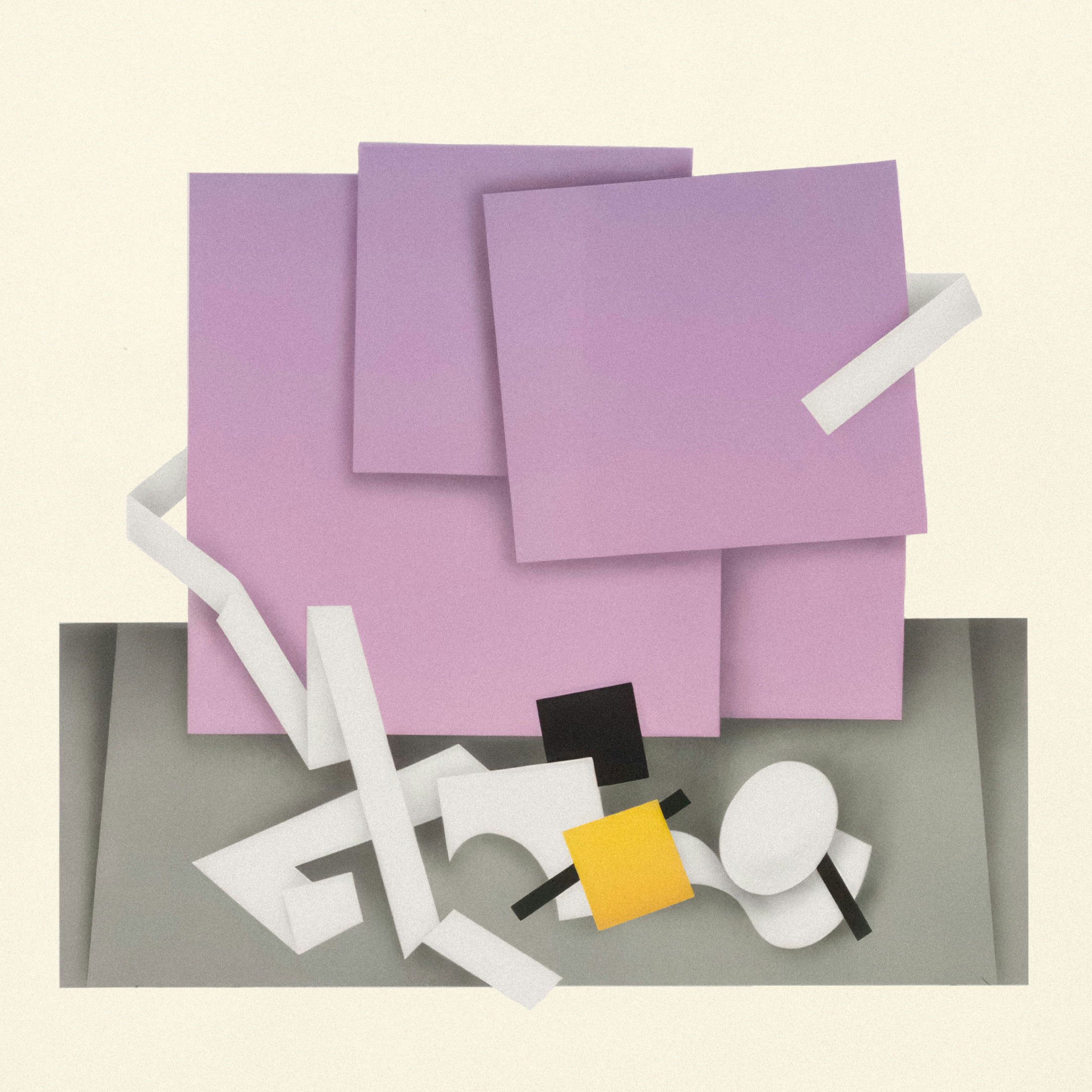 As you view this piece, I challenge you to picture it as “zoomed out” in comparison to the other pieces. Imagine that its scope has to be much larger! Shapes of yellow and black that previously seemed central are now laying small against a massive, layered backdrop that’s bright with the shades of a dawn sky. The white from earlier pieces now wraps around the sky and amongst the shapes on the ground, even supporting the yellow and black shapes. It’s as if the whole “stage” is now visible, and the end is clear.
As you view this piece, I challenge you to picture it as “zoomed out” in comparison to the other pieces. Imagine that its scope has to be much larger! Shapes of yellow and black that previously seemed central are now laying small against a massive, layered backdrop that’s bright with the shades of a dawn sky. The white from earlier pieces now wraps around the sky and amongst the shapes on the ground, even supporting the yellow and black shapes. It’s as if the whole “stage” is now visible, and the end is clear.
Podcast: Play in new window | Download
We are in Part IV of our ongoing series in the book of Matthew. In the Gospel according to Matthew, Jesus is inviting us into a whole new way of life with a new set of values and a new type of community. Really, it’s a whole new Kingdom that is being established right here and right now in the middle of this world. And compared to some of the prevailing values of our culture, it’s a bit of an “upside down Kingdom.” It’s a Kingdom where the outcasts are welcomed, the humble are honored, enemies are loved, the poor are esteemed, strangers are befriended, and the guilty are forgiven. It’s a Kingdom where the King is enthroned on a cross, His victory comes through His death, and His death gives life to the world.
Watch or re-watch the 6pm Good Friday Service
Friday, April 2 • 6PM
Scriptures takes us to the scene of our Lord’s betrayal, arrest, trial, crucifixion, and burial, setting us up for a deep celebration of Jesus’ resurrection on Easter Sunday.
Content above begins at 34:08.
In our sexualized age, it’s difficult to discern what exactly our sexuality is for. Questions of identity quickly surface. Our longings for fulfillment are deep and often complex. And loud voices all around us claim versions of liberation. All along, God stands ready to save, speaking into the confusion with kindness and clarity. God—the creator of our bodies, the one who spoke into existence our sexuality and capacities for pleasure and relationship—has laid before us His true, good, and beautiful design for it all. As men who follow Jesus, we want to hear what He has to say, learning to live as whole beings, walking as disciples who enjoy the healing presence and genuine freedom afforded us in the grace of Christ. Let’s do that together.